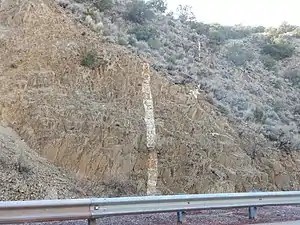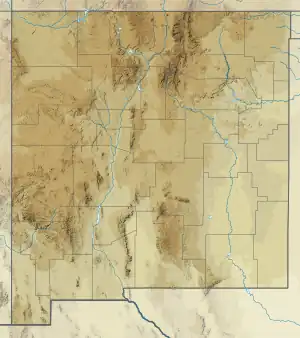Marquenas Formation
The Marquenas Formation is a geological formation that crops out in the Picuris Mountains of northern New Mexico. Detrital zircon geochronology gives it a maximum age of 1435 million years, corresponding to the Calymmian period.
| Marquenas Formation | |
|---|---|
| Stratigraphic range: | |
 Marquenas Formation with crosscutting dike, Picuris Mountains | |
| Type | Formation |
| Overlies | Piedra Lumbre Formation |
| Thickness | 500 m (1,600 ft) |
| Lithology | |
| Primary | Quartzite |
| Other | Metaconglomerate |
| Location | |
| Coordinates | 36.207°N 105.820°W |
| Region | Picuris Mountains, New Mexico |
| Country | United States |
| Type section | |
| Named for | Cerro de las Marquenas (36.207°N 105.820°W) |
| Named by | Long |
| Year defined | 1976 |
 Marquenas Formation (the United States)  Marquenas Formation (New Mexico) | |
Description
The Marquenas Formation was first believed to be over 80% quartzite, with the rest mostly metaconglomerate. The metaconglomerate lenses are found throughout the formation but particularly towards its top, and it was designated the Marquenas Quartzite.[1] However, Bauer and Williams noted that the unit is about equally divided between quartzite and metaconglomerate, which led them to redesignate it as the Marquenas Formation.[2] It can be divided into a lower, highly strained, poorly sorted boulder conglomerate; a middle quartzite member; and an upper, highly strained, pebble-to-cobble conglomerate.[3]
Cross stratification shows that the layering is overturned, and this supported the interpretation of the formation as part of the Vadito Group, likely correlating with the Big Rock Formation of the Tusas Mountains.[2] However, detrital zircon geochronology establishes a maximum age of 1435 Mya, much younger than the Vadito Group.[4] The provenance of the quartzite clasts in the Marquenas Formation remain uncertain, since they contain no aluminum silicate minerals and little crossbedding, but both are present in the Ortega Formation, the most likely local source rock.[2] One possibility is that the clasts were derived from quartzite units of the Manzano Group to the south.[5]
A metamorphosed tuff bed in the Pilar Formation yields an age of 1488 ± 6 Mya, and the Piedra Lumbre Formation likewise contains zircons dated to 1425 Mya. This suggests that the Pilar Formation and Piedra Lumbre Formation should be removed from the Hondo Group, and grouped with the Marquenas Formation as sediments deposited by the Picuris orogeny.[6]
 Coarse conglomerate at the base of the Marquenas Formation
Coarse conglomerate at the base of the Marquenas Formation Middle quartzite section of Marquenas Formation
Middle quartzite section of Marquenas Formation Sample of quartzite from the middle section of the Marquenas Formation
Sample of quartzite from the middle section of the Marquenas Formation Upper beds of Marquenas Formation
Upper beds of Marquenas Formation
History of investigation
The beds were originally assigned to the lower conglomerate member of the Vadito Formation by Arthur Montgomery in 1953, who estimated the thickness as up to 600 meters.[3] P.E. Long broke the beds out as the Marquenas Quartzite in 1976 and named them after Cerro de las Marquenas.[1] Paul W. Bauer and Michael L. Williams redesignated the unit as the Marquenas Formation in their sweeping revision of the stratigraphy of Precambrian rocks in northern New Mexico in 1989.[2]
Footnotes
- Long 1976, pp. 47–53.
- Bauer & Williams 1989, p. 49.
- Montgomery 1953, pp. 22–24.
- Jones et al. 2011.
- Holland et al. 2020.
- Daniel et al. 2013.
References
- Bauer, Paul W.; Williams, Michael L. (August 1989). "Stratigraphic nomenclature ol proterozoic rocks, northern New Mexico-revisions, redefinitions, and formaliza" (PDF). New Mexico Geology. 11 (3). Retrieved 15 April 2020.
- Daniel, Christopher G.; Pfeifer, Lily S.; Jones, James V, III; McFarlane, Christopher M. (2013). "Detrital zircon evidence for non-Laurentian provenance, Mesoproterozoic (ca. 1490–1450 Ma) deposition and orogenesis in a reconstructed orogenic belt, northern New Mexico, USA: Defining the Picuris orogeny". GSA Bulletin. 125 (9–10): 1423–1441. doi:10.1130/B30804.1. Retrieved 17 April 2020.
{{cite journal}}: CS1 maint: multiple names: authors list (link) - Holland, Mark E.; Grambling, Tyler A.; Karlstrom, Karl E.; Jones, James V.; Nagotko, Kimberly N.; Daniel, Christopher G. (September 2020). "Geochronologic and Hf-isotope framework of Proterozoic rocks from central New Mexico, USA: Formation of the Mazatzal crustal province in an extended continental margin arc". Precambrian Research. 347: 105820. doi:10.1016/j.precamres.2020.105820.
- Jones, James V., III; Daniel, Christopher G.; Frei, Dirk; Thrane, Kristine (2011). "Revised regional correlations and tectonic implications of Paleoproterozoic and Mesoproterozoic metasedimentary rocks in northern New Mexico, USA: New findings from detrital zircon studies of the Hondo Group, Vadito Group, and Marqueñas Formation". Geosphere. 7 (4): 974–991. doi:10.1130/GES00614.1. Retrieved 15 April 2020.
{{cite journal}}: CS1 maint: multiple names: authors list (link) - Long, P.E. (1976). "Precambrian granitic rocks of the Dixon-Penasco area, northern New Mexico" (PDF). New Mexico Bureau of Mines and Mineral Resources Open-file Report Series. 71. Retrieved 17 April 2020.
- Montgomery, Arthur (1953). "PreCambrian Geology of the Picuris Range, northcentral New Mexico" (PDF). State Bureau of Mines and Mineral Resources Bulletins. 30.